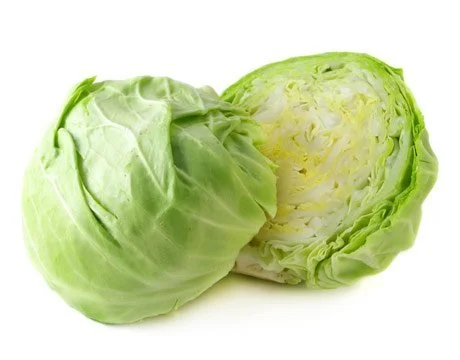Cabbage
The botanical name for cabbage is Brassica oleracea capitata. The English name cabbage comes from the French word caboche, meaning head, referring to its round form. Other vegetables related to the cabbage include Brussel sprouts, cauliflower, broccoli, kale, and kohlrabi.
History
Cabbage has been cultivated for more than 4,000 years and has been domesticated for over 2,500 years. Though many people connect cabbage to the Irish, the Celts brought cabbage to Europe from Asia around 600 B.C. Early cabbage was not like the full-bodied head grown today, but instead was more of a loose-leaf variety. Northern European farmers developed the head variety in the Middle Ages. French navigator Jacques Cartier brought cabbage to the Americas in 1536.
Preparation
Cabbage contains isothiocynates that breakdown into smelly sulfur compounds when cooked. The longer the cabbage is cooked, the stronger the smell becomes. Aluminum pans also increase the reaction. The solution to smelly cooked cabbage then is a short cooking time in stainless steel pots and pans. Cook the vegetable, uncovered, in enough water to cover the vegetable. To keep the cooking time brief, boil the water before adding the cabbage and cook just until tender. Another option is to microwave the vegetable. Cut the cabbage in to wedges, sprinkle with water, and cook just until tender. Or to eliminate cooking altogether, enjoy cabbage in a salad like coleslaw.
One medium head of cabbage is equivalent to 2 pounds of cabbage or 4 servings. One pound of raw cabbage is equivalent to 2 cups cooked.
Nutrition
Cabbage is a member of the cruciferous vegetable family and may reduce the risk of some cancers including colorectal cancers. Nutritionally, cabbage is high in beta-carotene, Vitamin C, and fiber.
Unfortunately, some people don't benefit from eating cabbage because they see it as an unpleasant vegetable with a bad odor. However, the cook, not the cabbage should be blamed for this problem.
Nutritional Information (per half cup cooked green cabbage): 16 calories, 3.6 mg carbohydrate, 2.9 g fiber, 18.2 mg Vitamin C.
Selection
All varieties of cabbage are available all year round. When selecting cabbage for purchase look for large, compact heads that are heavy for their size. Choose those with tender green leaves showing no signs of damage or insect nibbles.
Storage
At home, store the whole head of cabbage in a plastic bag in the refrigerator for up to one week. Fresh cabbage from the garden will last up to two weeks. The older the cabbage gets though, the stronger the flavor and odor will be. Once the head is cut, the cabbage will lose its freshness so plan to use within a day. If the cabbage was fairly fresh when cut, the unused portion should last a couple days longer if put in a plastic bag and a couple drops of water are put on the cut side.
Cultivation
Cabbage is a hardy vegetable that grows well in fertile soil and takes only three months to grow.
“The best soil for cabbages is a rich mould, rather clayey than sandy; and it can scarcely be too much manured, as they are an exhausting crop… The time of sowing for the summer crop is the beginning of the August of the preceding year. An open spot of rich light earth must be chosen, and the seeds of this, and of all the kale tribe, require a covering of no more than an eighth, or a quarter of an inch, in the thickness of mould. In about six or eight weeks after the sowing, or after the plants have got several leaves, they are thinned; and those plants taken out of the seedbed are pricked into other beds, at three inches’ distance every way.” (Mrs Dalgairns's Kitchen)
Varieties
There are various shades of green cabbages available as well as red and purple varieties. Green cabbage is grown more often than the red or Savory varieties but red is being used more often for color in salads and cooked dishes. Savory varieties, which are dark green in color, are grown for salads and slaw.
Recipes
Spring Vegetable Soup
Ingredients:
* 1 Tbsp. extra virgin olive oil
* ¼ medium head red cabbage (about 2 cups), finely shredded
* 2 medium ripe tomatoes, seeded and chopped
* ½ cup canned artichoke hearts, drained and chopped
* 1 cup frozen or fresh green peas
* 2 ½ cups low-sodium tomato or vegetable juice
* 1 cup water
* 2 tsp. dried basil
* Salt and freshly ground black pepper, to taste
Directions:
In large soup pot, heat oil over medium heat. Saute cabbage, tomatoes, artichoke hearts and peas for 10 minutes. Add tomato juice and water. Bring to boil. Reduce heat, add basil and simmer for 10 minutes, or until all vegetables are tender and soup is piping hot. Serve in individual serving bowls. Season to taste with salt and pepper. Nutritional Information (per serving): 120 calories, 4 grams fat, 5 grams protein, 18 grams carbohydrate, 4 grams fiber, 200 mg sodium.
Makes 4 servings




